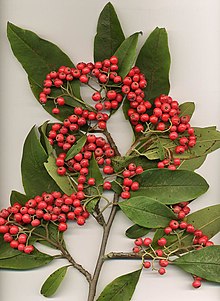Cotoneaster
| Cotoneaster | |
|---|---|
 |
|
| Cotoneaster frigidus foliage and fruit | |
| Scientific classification | |
| Kingdom: | Plantae |
| (unranked): | Angiosperms |
| (unranked): | Eudicots |
| (unranked): | Rosids |
| Order: | Rosales |
| Family: | Rosaceae |
| Subfamily: | Amygdaloideae |
| Tribe: | Maleae |
| Subtribe: | Malinae |
| Genus: |
Cotoneaster Medik. |
| Species | |
|
See text |
|
See text
Cotoneaster /kəˈtoʊniːˈæstər/ is a genus of flowering plants in the rose family, Rosaceae, native to the Palaearctic region (temperate Asia, Europe, north Africa), with a strong concentration of diversity in the genus in the mountains of southwestern China and the Himalayas. They are related to hawthorns (Crataegus), firethorns (Pyracantha), photinias (Photinia) and rowans (Sorbus).
Depending on the species definition used, between 70 and 300 different species of Cotoneaster are described, with many apomictic microspecies treated as species by some authors, but only as varieties by others.
The majority of species are shrubs from 0.5–5 m (1.6–16.4 ft) tall, varying from ground-hugging prostrate plants to erect shrubs; a few, notably C. frigidus, are small trees up to 15 m (49 ft) tall and 75 cm (30 in) trunk diameter. The prostrate species are mostly alpine plants growing at high altitudes (e.g. C. integrifolius, which grows at 3,000–4,000 m (9,800–13,100 ft) in the Himalayas), while the larger species occur in scrub and woodland gaps at lower altitudes.
The shoots are dimorphic, with long shoots (10–40 cm (3.9–15.7 in) long) producing structural branch growth, and short shoots (0.5–5 cm (0.20–1.97 in) long) bearing the flowers; this pattern often developing a 'herringbone' form of branching. The leaves are arranged alternately, 0.5–15 cm (0.20–5.91 in) long, ovate to lanceolate, entire; both evergreen and deciduous species occur. The flowers are produced in late spring through early summer, solitary or in corymbs of up to 100 together. The flower is either fully open or has its five petals half open 5–10 mm (0.20–0.39 in) diameter. They may be any shade from white through creamy white to light pink to dark pink to almost red, 10-20 stamens and up to five styles. The fruit is a small pome 5–12 mm (0.20–0.47 in) diameter, pink or bright red, orange or even maroon or black when mature, containing one to three (rarely up to five) seeds. Fruit on some species stays on until the following year.
...
Wikipedia
